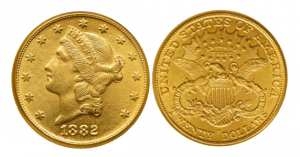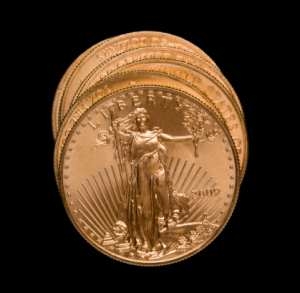

Many gold pieces often take on a life of their own, and avid collectors are almost always interested in understanding the background of a particular piece of minted metal -- in addition to learning about the monetary value of their coins. In essence, each coin tells a unique tale, and owners have the opportunity to become a permanent part of its ancestry. When it comes to an intriguing history, the renowned Double Eagle gold coin is known to have an incredibly storied past, intertwined in the United States economy and often shrouded in some degree of mystery. This is especially true with the famed 1933 Double Eagle, as this coin was never officially released into circulation and is still considered the “Holy Grail” of gold coins by most serious collectors.
The Double Eagle is a United States gold coin that was first minted in 1849 (around the same timeframe as the famous California Gold Rush). At that time, the coin’s face value was $20. The coins were created from 90 percent gold and 10 percent copper alloy, with a total weight of 1.0750 troy ounces (33.4362 grams). In that same year, the mint produced two pieces as “proofs.” One is still held in Washington, D.C. at the Smithsonian Institution, while the second was given to William M. Meredith, the U.S. Treasury Secretary who served during president Zachary Taylor’s brief administration from 1849 to 1850. However, this coin was eventually sold as part of Meredith’s estate and presently, its location is unknown.

Before 1850, Eagle coins of $10 were the largest denomination of any U.S. coin, these $10 Eagles were first minted in 1795, only two years after the first U.S. Mint was established in Philadelphia, PA. Since the $20 gold piece had twice the value of the original Eagle, these newer coins were (not surprisingly) designated as "Double Eagles." The 1oz of gold in the Double Eagle at current spot price is worth more than $1200.
Early Years of the Double Eagle Gold Coin
Additionally, other U.S. coins, known as the Eagle, Half Eagle and Quarter Eagle were given these names by Acts of Congress in 1792 and 1849, respectively. The Double Eagle coin was in regular production from 1850 until 1933 when President Franklin D. Roosevelt made it illegal to own gold and stopped the coinage of metal. Most 1933 Double Eagles were melted into gold bars. However, coin collectors were still allowed to retain their own pieces. Interestingly enough, although no 1933 Double Eagles were ever legally released, some somehow escaped the Mint and several have been recovered over the years.
The year 1934 saw the introduction of the United States Gold Reserve Act, which required that all gold and gold certificates held by the Federal Reserve be surrendered to the U.S. Department of Treasury. It completely outlawed possession of gold, forcing citizens to sell it to the treasury, who in turn stored the gold in the United States Bullion Depository at Fort Knox as well as other secret locations. According to historians, this act elevated the price of gold from $20.67 to $35 dollars per troy ounce. This price change gave foreign investors an incentive to export gold to the United States, while devaluing the U.S. dollar in an effort to create inflation. This act eventually resulted in a major accumulation of gold in the Federal Reserve and U.S. Treasury, which lowered interest rates as well.
Designs of Double Eagles: Liberty Head and Saint-Gaudens
The intricate design of the Double Eagle coins played an integral role in the coin’s exterior beauty. A number of subtle changes and adjustments were made over the years, affecting the collectible value of this coin as well.
Double Eagle coins were made in two major types: the Liberty Head Coronet (1849 – 1907) and the Saint-Gaudens (1907 – 1933).
The three distinctive Liberty Head styles include several versions: no motto, value "twenty D" 1849 –1866; Liberty Head with a motto, value "twenty D" 1866 –1878; and the Liberty Head with a motto, value written as "twenty dollars" 1877–1907.
Featuring artwork that is considered to be “less desirable” by collectors, the Liberty Head coronet $20 dollar gold pieces demand a lower price than the Saint-Gaudens coins. Several changes were made over the years. For example, in 1866 the motto, “In God we Trust,” was added to the Liberty Coronet Double Eagle, creating a second subtype. In 1877, the denomination design on the coin’s reverse side was changed from "twenty D" to read, "twenty dollars," creating a third subtype for the series.

In addition, the Saint-Gauden distinctive coin styles are varied as well. They include: a high relief, with Roman numerals, no motto 1907; the Saint-Gaudens low relief with Arabic numerals, no motto 1907–1908; and the Saint-Gaudens low relief with Arabic numerals, with motto 1908 – 1933.
The Saint-Gaudens Double Eagle is named for its designer, Augustus Saint-Gaudens a well-respected American sculptor. He created the high-relief $20 dollar gold piece that was considered by art aficionados to be an exceptionally designed piece. The mint, however, made a different low-relief version, as the high-relief was time-consuming and costly to produce. According to experts, a little over 12,000 of these coins were struck in 1907. These coins can command a price of over $10,000 to $500,000 in excellent condition.
Early years of this coin featured design changes. In 1907, the first coins issued featured a date in Roman numerals, but this was changed later that year to Arabic numbers. The motto "In God We Trust" was omitted from the initial design, as President Roosevelt believed that adding the name of God on money was inappropriate. However, the motto was added in mid-1908 through an act of congress.
In 1912, the design of the Saint-Gaudens coin was adjusted once again when New Mexico and Arizona became states. The number of stars along the rim was increased from 46 to 48. In later years, The Saint-Gaudens design was reused in the American Eagle gold bullion coins that were introduced in 1986. In fact, the early 1907 double eagles and the 1986 -1991 Gold American Eagles are the only instances where the date in Roman numerals was present on U.S. coinage.
The Double Eagle in recent years
Years later, in 2002 a 1933 Double Eagle sold for $7 million dollars at public auction, breaking the former record of $4 million dollars that was paid for a silver dollar from 1804. This piece is the only 1933 Double Eagle the government legalized for private ownership. Although a 1933 Double Eagle could be potentially worth hundreds of thousands of dollars, it is still illegal for anyone to deal one of these coins.
In 2009, the U.S. Mint released ultra-high relief Double Eagles featuring the iconic Saint-Gaudens design. The coins contain one ounce of .9999 fine gold. Due to the higher gold content (and greater striking pressure), the coins are 27 mm wide and 4 mm deep (the same diameter as a Gold Eagle), rather than the standard 34 mm by 2 mm usually chosen for Double Eagles and bullion coins. The initial selling price was over $1,200 -- and rose quickly. These one-time uncirculated issues have the date listed as "MMIX". Later that year, the one coin per person restriction was removed and the final mintage was 115,178.

Most recently, in 2015, the Double Eagle was the center of a major legal battle in Philadelphia, which became a milestone court decision regarding these legendary coins. Joan Langbord, a woman in her 80s, discovered ten 1933 Double Eagle coins in her family’s safe deposit box in 2003. The coins were linked to her father, Israel Switt, who was a jeweler and had business interactions with the U.S. Mint in the 1930s (and was investigated regarding his coins). The U.S. Department of the Treasury claimed the coins were stolen and the government won the legal case in 2012. However, after an appeals court overturned the verdict in 2015, Langbord (and her two sons) were awarded the rights to the ten gold coins – estimated to be worth approximately $80 million dollars.
Get Our Free
Investor's Guide
Posting in: